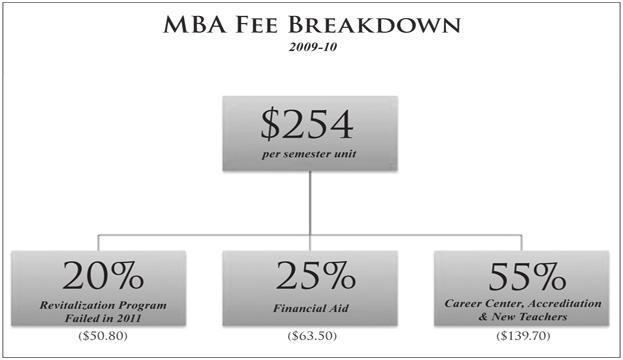When the Cal State University Board of Trustees passed the CSU-wide masters of business administration fee in 2009, the extra $254 a semester per MBA student was intended to maintain the program’s accreditation from the Association to Advance Collegiate Schools of Business.
At Cal State Long Beach, 20 percent funds generated by the fee went to a revitalization program struck down by the faculty.
Dean of the College of Business Administration Michael Solt started a revitalization program to create a new curriculum and career opportunities for students.
The program began in 2009 and ended in 2011 due to lack of faculty support.
Solt’s program reduced the 10 required courses taught in a classroom setting to five. Some of the courses are now online and others have been worked into new integrated courses.
However, faculty did not support cutting class hours, Solt said.
The program also held workshops for faculty members during winter 2010 and summer 2011. The 43 faculty members who participated were paid $3,000 each, Solt said.
Even though the program did not last, the workshops created new curriculums, including integrated courses.
The courses, which include globalization in global business, customer relationship management and financial statement analysis, combine multiple subjects into one session.
Ingrid Martin, chair of marketing at CSULB, participated in the workshops and helped develop the new integrated course on sustainability and business organization. The two-part eight-unit course has three to four faculty members teaching the class during each session.
“I think it really worked out great,” Martin said. “We’ve received great feedback from students.”
Nonetheless, MBA students were not expecting the money to be spent on the revitalization program. International MBA student Victor Liu was outraged when he discovered that his scholarship money may have been questionably spent on a failed revitalization program.
“I am an international student going to school on a scholarship,” he said. “This makes me so frustrated.”
Senior English education major and former president of the College of Liberal Arts, James Sauzo, was outraged when he found out about the MBA fee spending in the original report by California Watch. Suazo said he wants CSULB to set a better example to the public and show that CSULB can spend fees correctly.
“Especially in this time and environment as now with so much concern on budget cuts, student fees are not being spent responsibly,” Sauzo said.
Sophomore year MBA student Kyle Roddy said that the fee is acceptable if it is being spent correctly in the MBA program.
“I prefer that it be spent on faculty,” Roddy said. “I would rather have them spend the money on new teachers.”
Natalie Liberman, a junior marketing major, has seen her class sizes increase as an effect of courses being cut, but she still thinks the program was not a waste.
“I mean, they tried,” Liberman said. “There was an effort made.”
For the extra revenue generated from the May 2009 MBA fee, Solt is in charge of determining how the money should be divided.
“We are spending with trustees in mind,” Solt said. “We follow guidelines 100 percent to the letter.”
At the 2009 Board meeting, the fee was also designed to hire qualified faculty, support enrollment and diversify the MBA student body.
One-third of the fee revenue is automatically set aside towards financial aid for students in the MBA program. If that portion of the fee is not used towards financially needy students in the MBA program, then the money will go towards students in other programs on campus.
Solt also invested in the Career Development Center, specifically to benefit students in the MBA program with job guidance and opportunities. Also, lecturers were hired to take over classes so faculty members could have more time for research.
“Faculty research is a part of accreditation,” Solt said.
MBA program coordinator and Career Services Manager Kathy Rice said she understands the rationale of the fee but does not agree with the cost for the CSU level. She showed support for putting the money back into the MBA program by updating courses.
“There are stringent guidelines of where the fee is parceled out to,” Rice said. “I support [Dean Solt and fee managers] in what they do.”
Currently, the MBA program has ACSB accreditation. Every five years, the program is reviewed.
“There is no attempt to do anything better than to improve the MBA system,” Solt said.





I have no problem with the idea of spending on MBA revitalization.However, in my opinion, the money was spent vainly since the faculty never supported the specific effort undertaken and it was clear from beginning to end that faculty did not support the effort. Largely the issue is that faculty did not believe that the approach suggested by GPC Chair Ingrid Martin would be implementable and would achieve the desired outcomes. Ultimately the effort wasn’t even put up for a faculty vote since it was clear the necessary support would never materialize And the Graduate Programs Chair herself was paid a lot of extra $$ for this effort that never went anyplace. I headed the last AACSB accreditation effort myself but have since resigned because I feel the CBA is going in the wrong direction. I feel like the college desperately needs new leadership.